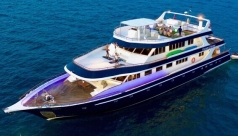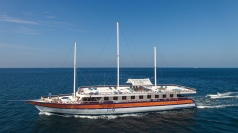The Climate, Diving Season and Best Time to Visit
The recommended months for confirmed liveaboard departures are from November to May but the Maldives scuba diving season runs all year round. The northeast monsoon (winds from the northeast) runs from the end of December to May. At this time of year the skies are blue and the lack of wind means the seas are calm. The visibility on the eastern side of the atolls is good at 20-30+m, and 15-20m on the western sides. The eastern atolls generally have the best visibility during this time too, and December to March normally enjoys the best overall visibility. This is because the currents flow through the atoll channels from east to west. Reef sharks gather in large numbers at the channel entrances on the eastern side of the atolls; whereas mantas are drawn to the western sides because plankton flows out of the channels into open sea to the west at this time. The current is strongest at this time of year too.
June to November is the southwest monsoon and the above process is reversed - currents run through the channels in an easterly direction; mantas to the east, reef sharks and better visibility to the west. The skies are cloudier, the winds are stronger and seas a little rougher, although the season does still get nice, sunny spells. Surface swells can reach 1-2m, particularly during the rainy season in June/July, when rain falls on average 3-4 hours per day, and during the monsoon transitions in late May and early December. It may be more difficult to find a liveaboard departure date in the Maldives that suits you in this period.
Water temperatures are fairly constant throughout the year at 26-29°C, except in the far south where the water temperature can drop to 24°C during the northeast monsoon. Having said all that, like most places in the world, the seasons in the Maldives have become less predictable in recent years.
Mantas, whale sharks, turtles, reef sharks and hammerhead sharks are found in the Maldives all year round; if anything, manta rays are found in even greater numbers in the southwest monsoon. As for the other big creatures, diver encounters are dependent on non-seasonal factors: whale sharks are more frequently sighted at high tide, and hammerhead sharks ascend to shallower water at sunrise.
Ports of Departure and How to Get There
Liveaboards that cruise the Central Atolls use Hulhule, next to Male International Airport, as their operating port. This means that guests can have a hassle-free transfer from the airport arrivals hall to their boat. You might even arrive in Maldives and be diving on the same day! Everyone flies into Male Airport and you will be met there by representatives of the cruise. More information on: how to get to the Maldives.
For your peace of mind, we strongly advise securing comprehensive insurance coverage for all diving and travel activities, including protection against trip cancellations. Our recommended insurance program offers competitive rates tailored specifically for dive vacations. Request a personalised quote when booking your stay:

Places to Stay
For convenient pre- or post-liveaboard safari stays in the Maldives, our trusted partner HotelsCombined.com offers an extensive selection of accommodations. Their platform features easy online browsing with instant chat support, secure credit card bookings, and 'Best Price Guarantee' for maximum value. Book your perfect stay at www.hotelscombined.com:

Travel Tip: If you have a layover in Malé, consider booking a day room at an airport hotel on Hulhule Island or in the city center. These provide shower facilities, luggage storage, and a comfortable base to explore before your onward journey.










































